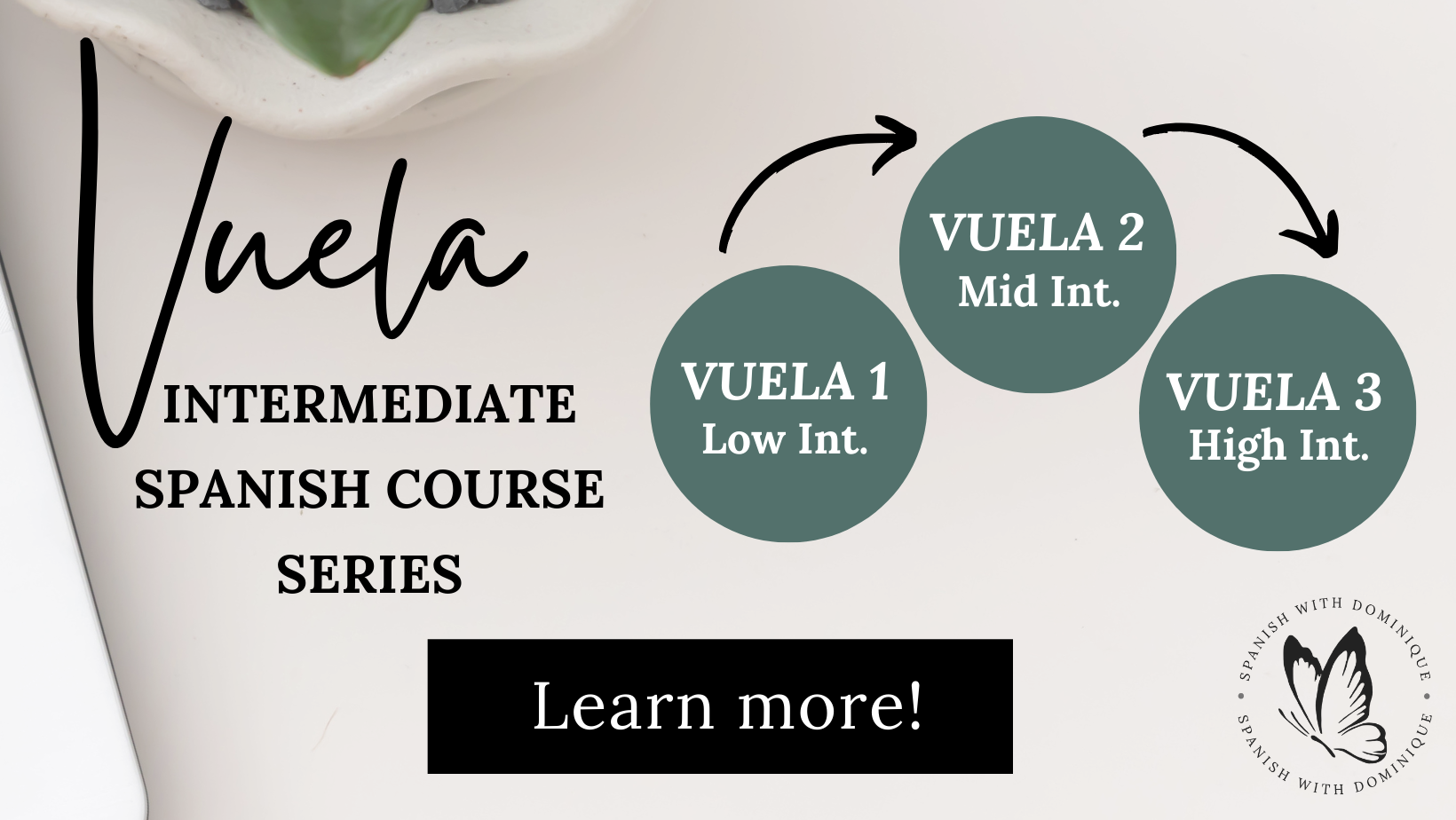The 3 Major Differences Between Mexican Spanish and Spanish from Spain
In this post: The three easiest ways to differentiate Castilian Spanish from Mexican Spanish.
So you’ve finally decided to go all in and start learning Spanish as an adult. And you can’t wait to be able to speak with your neighbors, your patients, and your in-laws.
But now you’ve got a question:
Should you learn the kind of Spanish spoken in Spain (Castillian Spanish)? Or should you learn the kind of Spanish spoken in Mexico?
And what exactly is the difference between Castilian Spanish (Spanish from Spain) and Mexican Spanish?
You’re asking all the right questions. After all, Spanish is the second most spoken language in the world, with 500 million Spanish speakers in 21 different countries. So, of course, Spanish has a rich heritage, and there are diverse ways of speaking it, depending on where you travel. In fact, even if you stay in the US, you’ll encounter many different types of Spanish.
So, as an adult learning Spanish, where do you begin?
In this post, we’ll take a look at some of the ways that Castilian Spanish and Mexican Spanish are unique — and beautiful. I’ll also share my own experience learning both of these Spanish accents and how I came to accept and love my own one-of-a-kind accent — the way I hope you will grow to love your own Spanish accent.
By the end of this post, you’ll know some of the key differences between these two widely-spoken versions of Spanish. And you’ll know where to begin your own Spanish-learning journey.
¿Listo?
While reading this post, consider these questions:
Can people instantly tell where you’re from when they listen to you speak? Does your accent ever change depending on your situation?
Are you learning Spanish to speak with someone in particular, or to travel to a specific place? What accent might help you do that?
What kind of Spanish is spoken near where you live?
1. Pronunciation Differences between Mexican and Castillian Spanish — and why it matters to you?
If you listen to people from the UK, Australia, India — or just different regions in the US — you’ll notice that there is a wide variety of English accents. The same is true for Spanish.
In fact, if you start out learning Mexican Spanish and travel to Spain, you’ll probably hear the difference right away. Read on for an overview of the telltale differences between Castillian and Mexican Spanish.
In Spain, the “c” and “z” make a “th” sound
The most obvious difference you’ll hear is the pronunciation of certain letters. In Spain, the letters "z" and “c” (and sometimes even the letter “s” in some regions) are pronounced like a soft "th" sound when they come before certain vowels.
Por ejemplo…
The word cielo or ‘sky’ sounds like “th-ielo” in Spain and “s-ielo” in Mexico.
The word zapato or ‘shoe’ sounds like “th-apato” in Spain and “s-apato” in Mexico.
The word cereza or ‘cherry’ sounds like “th-ere-th-a” in Spain. “s-ereza” in Mexico.
If you’ve got your heart set on using a Mexican accent, then I’ve got some good news for you - both the “z” and “c” sounds in these instances are both pronounced like an “s,” never “th.”
(Phew! One less thing to think about.)
But, if you’re dreaming of using a Castillian accent, then I would definitely read and listen up on how to pronounce the Castillian “c” and “z” sounds to sound more like a local.
Does it matter if you have a Spanish or Mexican accent?
The answer depends on you. The incredible thing about learning Spanish as an adult is that you can pick the accent you learn. This is not a luxury you have in your native language.
When I was living in Spain, I was very self-conscious about my accent and wanted to sound less “American”. I worked so hard to soften that American accent.
And then, when I got back to California, people noticed my “strange” way of pronouncing my “z” and “c” sounds. My accent went from being ‘too American’ to too Castillian (and a definite conversation starter because everyone wanted to know where I got my accent).
Over time, I chose to adapt my pronunciation to feel more at home in California and Mexico — since I now spend much more time in Mexico than in Spain. But, that was a personal choice.
I’ve been told, though, that the underlying singsongy cadence of how I speak in Spanish is still very much Castillian. And I’m proud of that because it reflects the complete picture of my Spanish.
I’ve even learned to appreciate my American accent in Spanish because that was my first language, and it’s a part of who I am, too.
Point being: the accent you choose to have is up to you. Your unique accent is something you can be proud of — whatever you decide it is.
Choose the accent you like the best and that has meaning for you, and start your Spanish learning journey there.
Is a Castillian (or Spanish) accent or Mexican accent easier to learn?
This is a great question I often get from my students. You can absolutely learn either accent — and make changes over time.
Now, if you’re first starting out, my advice to you is to focus on one Spanish accent.
As you build confidence, you’ll be able to use your Spanish to connect with people across the Spanish-speaking world — regardless of the country-specific accent you learned to begin with.
However, if you are really dying to know which one is easier from someone who’s learned both Mexican and Castillian Spanish, I found that the Mexican (and largely Latin American) accent was easier to learn as an English speaker. It seemed more intuitive.
But that’s not to say that I don’t love the sound of Castillian Spanish being spoken — it takes me back to a really happy time in my life.
2. Vocabulary and Slang Differences in Castillian (Spanish) and Mexican Spanish
If you learn Mexican Spanish, will they still understand you in Spain? Or vice versa?
People worry about this a lot. But the short answer is, “Yes, they will understand you just fine.” It’s just like an American speaking with someone from Ireland; they totally understand each other but are bound to have some “lost-in-translation” moments where a new vocabulary word is introduced.
Same thing with Mexican and Castillian Spanish - there are times when a word or expression can cause confusion.
But, most of the time, once you reach an intermediate level of Spanish, you’ll have gained the ability to talk your way around the expressions that aren’t the same. Or just find out what new words mean through context.
When you’re shifting from one accent to another, you should also watch out for expressions that could actually be considered vulgar in either Spain or Mexico. (word of warning - there are a surprisingly large number of those words, particularly when in Mexico)
But, once you push yourself towards an intermediate conversational level of Spanish, you’ll have ways to work around any expressions you don’t know and quickly figure out which words people are or aren’t using — with the occasional “lost in translation” moments that everyone can have a good chuckle about.
A few commonly used words that are different in Spain and Mexico.
Of course, there will be times when there are words and expressions that are specific to Mexico, or specific to Spain. Here are just a few of the most common examples of words that don’t mean exactly the same thing in Castillian and Mexican Spanish:
Fresa: Just like in Spain, ‘fresa’ refers to strawberry but is also used colloquially to describe a preppy or snobby person. (In Spain, they say ‘pija.’)
Papa: In Mexico, ‘papa’ means potato, while in Spain, they say “patata.’ Actually, the only ‘papa’ that exists in Spain is ‘el Papa’ — the Pope!
Estar crudo: In Spain, it simply means ‘to be raw/uncooked. ’ But, in Mexico, you’ll hear it used to describe being hungover after a wild night of drinking (in Spain, you would simply say ‘tener resaca’)
¡Qué padre!: In Mexico, this is used to refer to something cool, while in Spain, they say, ‘¡Qué guay!’ Actually, the only ‘padre’ in Spain is your father!
Coger: In Spain, this verb is used for taking the bus or a taxi, but be careful because, in Mexico, it’s vulgar (just take it from me and use the verb ‘tomar’ instead while in Mexico)
Indigenous words and expressions Mexican Spanish
Spanish is a culturally rich language, and in Mexico, it has been heavily influenced by indigenous languages like “Nahuatl.” However, some of these have made it back into Spain.
For example, chocolate originates from the Nahuatl word "xocolatl." The bitter drinks the Aztecs used to make it from roasted cacao beans. Of course, the Spanish later brought chocolate back to Europe — so they have definitely heard of this!
The question of Mexican Slang Expressions…
If you live in a place long enough or enjoy its culture, you will learn to brighten up your language with a bit of slang. And Mexico certainly has a long tradition of fun slang expressions.
Here is one of my favorite resources 29 Mexican Slang Words & Phrases To Sound Like A Native In No Time!
As you progress in Spanish, be sure to learn a few slang phrases, too — from whatever accent you choose to study. Because anywhere you go in Mexico, it will be handy to know expressions like ¿Qué onda? (What’s up?) or ¡Qué padre!(How cool!).
3. Spanish Grammar Differences between Spanish in Spain and Mexico
Here is the question you’re getting ready to ask me. I can feel it:
Do I really need to learn the vosotros conjugation? (This is an important question, especially if you want to sound like someone from Mexico, not from Spain.
Here’s the good news: if you want to learn Mexican Spanish, you can cross vosotros off all your conjugation tables (Woohoo! One less thing to learn!)
In my ALAS Basic Spanish Course Series, I don’t teach this conjugation because you don’t need it to communicate in Latin America. As someone who learned Spanish from start to finish, I cut all the fluff out of my courses (like unnecessary conjugations) and jump right into the practical stuff that will get you using the language faster.
But…will people understand you if you go to Spain and only use ustedes?
Absolutely! They will absolutely understand you. Do British people have to learn “American” before they vacation in the US?
If you’re planning an upcoming trip to Spain, I just recommend that you brush up on your listening comprehension of Castilian Spanish to better understand locals using vosotros, but you don’t have to personally use it in your own conversations.
The endearing usage of the diminutive in Mexico
Ah, the diminutive — it’s one of the nuanced parts of Mexican Spanish (and Latin American Spanish in general) that I really adore.
But what is the diminutive exactly?
Well, the diminutive is just a smaller (and many times more endearing) version of whatever you’re talking about. Think of the way we add —y or —ie, to words in English, such as birdie, kitty, booties, and sweetie.
In Spanish, you can often form the diminutive of a noun by adding —ita to feminine nouns and adjectives, or —ito to masculine ones.
Por ejemplo:
Beso ⇒ Besito (little kiss)
Casa ⇒ Casita (little house)
Perro ⇒ Perrito (little dog)
Abuela ⇒ Abuelita (little grandma)
Lirbo ⇒ Librito (little book)
You might be thinking that’s a bit strange. I mean, are there more mini-versions of everything in Mexico? Ha! Not at all.
In Mexico, when someone uses the diminutive, they aren’t necessarily talking about something small. They use it to create a feeling of closeness, warmth, or endearment. (The diminutive actually has a long and beautiful history in Mexican Spanish).
Culture experts think that one of the origins may be the Nahuatl language, spoken in Mexico before the Spanish conquest. In Nahuatl, the diminutive was used to create different meanings — a bit like families of words — in which one use was to communicate love and respect.
The present perfect is more commonly used in Spain than in Mexico.
Which of these would you be more likely to say?
“Darn it, I locked my keys in the car!”
or
“Oh bother, I have locked my keys in the car!”
As you can see, they are both correct. You can understand exactly what they mean as a native speaker of English. But…the second one sounds a bit more natural if you apply a British accent.
In the US, when we’re talking about something that just happened, we’re much more likely to use the simple past (locked) than the present perfect (have locked).
In Mexico, you are more likely to hear someone using **the preterit tense to talk about something they just did rather than in the present perfect. A bit like you would in the US.
If you wanted to say you recently ate…
In Mexico, you’d use the simple past: Yo comí.
And in Spain, you’d use the present perfect: Yo he comido.
And if you wanted to say that you just saw your friends at the market…
In Mexico you’d use the simple past: Nosotros vimos a nuestro amigo en el mercado.
And in Spain you’d use the present perfect: Nosotros hemos visto a nuestro amigo en el mercado.
And remember, whether you’re speaking to someone from Spain or Mexico, they’ll understand you no matter which tense you use.
Your Key Takeaways about the Styles of Spanish spoken in Spain and Mexico.
I hope that you’ll enjoy exploring the deep and beautiful variations in Spanish — whether you are studying Castillian Spanish or Mexican Spanish…or one of the other incredible country-specific accents out there. Remember to begin with one accent when you are starting out — this will make everything easier for you.
And remember that if you want to add, change or personalize your accent later on — you absolutely can. That’s what I did by layering my experience with the culture and accent from Mexico City over my initial Spanish from Barcelona.
Who knows what cultures and accents you will add to your mix once you start to feel confident in your Spanish? And it’s all up to you.
Every addition to your accent and the way you speak is a chance to make your accent, and your Spanish uniquely yours.
More Posts Handpicked Just For You!
Enjoyed this post? Here are some more you might like.






Discover 7 must-read books for intermediate Spanish learners to boost fluency, overcome the plateau, and immerse yourself in engaging Spanish stories.